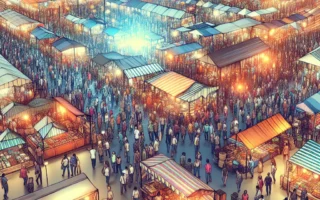The Impact of Technology on Traditional Fairs
The Impact of Technology on Traditional Fairs
Traditional fairs have always been a celebration of local culture, crafts, and community spirit. However, the rapid advancement of technology has brought about significant changes to the landscape of these events. One of the key impacts of technology on traditional fairs is the shift towards digital marketing and promotion. In the past, fairs relied heavily on local advertising, word-of-mouth, and physical signage to attract visitors. Today, social media, online advertising, and mobile apps play a crucial role in reaching a wider audience and engaging potential fair-goers.
Moreover, technology has also revolutionized the way traditional fairs are organized and managed. Event management software, online ticketing systems, and virtual maps have streamlined the logistical aspects of fairs, making it easier for organizers to plan and execute successful events. Additionally, the integration of cashless payment systems and digital transactions has transformed the way transactions are conducted at fairs, offering convenience and efficiency to both vendors and attendees.
Furthermore, the digital age has expanded the possibilities for interactive experiences at traditional fairs. Augmented reality (AR) and virtual reality (VR) technologies have the potential to enhance visitor engagement and provide immersive experiences, bringing a modern twist to traditional fair activities. Technology also enables fairs to offer online streaming of live performances, virtual tours of exhibits, and interactive games, creating new avenues for audience participation and entertainment.
However, while technology offers numerous benefits to traditional fairs, it also presents challenges. The increasing reliance on digital platforms can potentially alienate certain segments of the community, especially those who may have limited access to technology or prefer traditional forms of communication. Additionally, the digitalization of fairs raises concerns about data privacy, cybersecurity, and the need for robust technological infrastructure to support the seamless integration of digital elements into traditional fair settings.
In conclusion, the impact of technology on traditional fairs is undeniable. While it brings forth opportunities for innovation, efficiency, and enhanced experiences, it also necessitates a careful navigation of the potential challenges and a balanced approach to preserve the authentic charm and inclusive nature of traditional fairs in the digital age.
Thank you for using requested text in your article. If you require any further information or assistance, please feel free to ask.
Adapting to the Digital Landscape: Strategies for Fair Organizers
In the rapidly evolving digital landscape, fair organizers are facing new and complex challenges as they navigate the future of fairs. The traditional model of fairs is being disrupted by the digital age, demanding a shift in strategies to adapt to the changing environment. The key to success lies in embracing technology and leveraging digital tools to enhance the fair experience for both exhibitors and visitors.
One of the primary strategies for fair organizers to thrive in the digital age is to harness the power of online platforms. Establishing a strong online presence through social media, event websites, and virtual exhibition spaces can significantly expand the reach of fairs beyond physical boundaries. By utilizing digital marketing techniques such as targeted advertising and email campaigns, organizers can attract a wider audience and drive engagement.
Furthermore, integrating virtual components into traditional fairs can extend accessibility and convenience. Offering virtual tours, livestreams, and interactive online activities can cater to individuals who are unable to attend in person, thereby broadening the fair’s overall impact. Embracing virtual elements also presents opportunities for innovative partnerships with tech companies and digital platforms, paving the way for unique and immersive fair experiences.
Adapting to the digital landscape also entails prioritizing data analytics to gain valuable insights. By leveraging data collected from online interactions and engagements, fair organizers can better understand visitor preferences, optimize exhibit layouts, and tailor content to maximize impact. This data-driven approach allows for informed decision-making and the ability to continually improve the fair experience based on real-time feedback and analysis.
In conclusion, fair organizers must proactively adapt to the digital age by embracing online platforms, integrating virtual components, and utilizing data analytics. Embracing these strategies will not only help fairs thrive in the evolving digital landscape but also enhance the overall experience for both exhibitors and visitors, ensuring the continued relevance and success of fairs in the future.
Balancing Tradition and Innovation: The Evolution of Fairs
In the face of the digital age, traditional fairs are challenged to strike a balance between upholding time-honored customs and embracing innovation. The evolution of fairs reflects a dynamic blend of tradition and modernity, as organizers seek to cater to changing audience preferences while preserving the essence of these age-old gatherings. Fairs, rooted in history and culture, are increasingly incorporating digital elements to enhance the visitor experience and reach wider audiences. This evolution presents a unique opportunity for fairs to maintain their traditional charm while leveraging digital tools to stay relevant in today’s fast-paced world.



